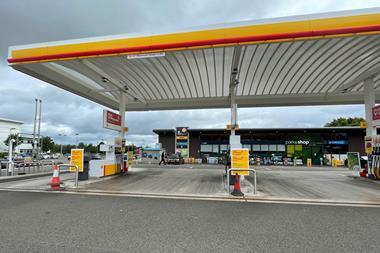Retailers and trade associations have united in their disappointment that a tobacco display ban will go ahead in England despite any credible evidence that concealing gantries reduces smoking.
The announcement by health secretary Andrew Lansley on March 9 has also been met with surprise. The Conservatives had previously suggested they would be against such a move when proposals to ban displays were introduced.
Retailers have been granted an additional 18 months to make the necessary changes, according to the government’s Tobacco Control Plan. The implementation dates for small stores (up to 3,000sq ft) have been pushed back from October 1, 2013 to April 6, 2015. Larger stores (over 3,000sq ft) have had their implementation date extended by six months to April 6, 2012.
Jonathan James, who runs four forecourts in Cambridgeshire, said: "The announcenment is indicative of this Coalition government they say one thing in opposition and something totally different later. I fail to see what a display ban will achieve. It’s a sledge hammer to crack a nut and is only going to drive the illicit trade and make it even easier for them."
Phil Tout, who runs two forecourts in Somerset, said he was surprised that the government has decided to go ahead with plans for a display ban. "I thought it wouldn’t happen; it’s silly," he said. "It’s going to make it difficult trying to serve cigarettes it’ll make the job hard work.
"It is helpful to us that we have longer now to implement it but I can’t see the sense in it. It’s not going to stop anyone smoking; it’s just going to make it harder for us to sell tobacco products and will slow down transactions."
Association of Convenience Stores chief executive, James Lowman, said: "We are disappointed that government are pressing ahead with a tobacco display ban imposing £40m of costs on small retailers. There simply isn’t the evidence to suggest that the measure will reduce smoking amongst young people. The concessions made are not sufficient to allay the long-term harm that this measure will cause for local shops."
Christopher Ogden, chief executive of the Tobacco Manufacturers’ Association (TMA), said he was pleased that the government had decided to delay the implementation of the display ban but hopes they will review the legislation again and decide to revoke it. "There is no credible evidence to support the stated public health objective that restricting tobacco displays will reduce youth smoking levels," he said. "The TMA shares the government’s view that minors should not smoke and they should not have access to tobacco products. Proof-of-age schemes and rigorous enforcement of laws on under-age sales are more effective solutions to the issue of preventing youth access to tobacco and the TMA is fully committed to supporting these activities."
The government has attempted to make it easier for retailers to comply with the ban by relaxing some of the legislation covering gantry replenishment. Health secretary Lansley said this "greater flexibility" would ensure that retailers could "more easily carry out the day to day running of their businesses without breaching the law for example, being able to undertake stocktaking or maintenance while there are customers in the shop."
The size of the display allowed while serving customers or carrying out the other authorised activities will increase from 0.75 to 1.5sq m.
Lansley also revealed that the government had not given up on the idea of plain packaging. He said it will consult on options to reduce the promotional impact of tobacco packaging, including plain packaging, and an assessment of the impact of these options would be made before the end of the year.
TMA’s Ogden said: "The TMA is strongly opposed to the principle of plain packaging and would expect a genuine consultation and regulatory impact assessment if the government decides to pursue this further. We do not believe any plans for plain packaging are based on sound public policy, nor any compelling evidence. Plain packs are also likely to lead to yet further increases in the smuggling of tobacco products and they would make it so much easier for a counterfeiter to copy than existing branded packs making it even more difficult for a consumer to differentiate between genuine and counterfeit products."
Meanwhile, in Scotland an ongoing legal challenge from Imperial Tobacco has held up implentation of a display ban. However, public health minister Shona Robison confirmed that she was keen for Scotland’s implementation dates to mirror England’s. "Through our work with retailers it has become clear that there is support for the ban to come into force at the same time both north and south of the border," she said.
The Welsh Assembly has said it is committed to a ban but timing is subject to the outcome of England’s Judicial Review. In Northern Ireland (NI), the NI Independent Retail Trade Association is calling on the NI Assembly to give retailers more time to get ready for the ban the NI ban is due to come into effect for all retailers on July 1.
news from the budget
In his Budget on March 23, Chancellor George Osborne increased tobacco tax by 2% above inflation but also increased duty on hand-rolling tobacco by a further 10%. The duty hike makes the cost of cigarettes as much as three-and-a-half times more expensive than many other European countries. James Lowman, chief executive of the Association of Convenience Stores, said: "The rise in tobacco duty will drive consumers away from legitimate retailers into a dangerous illegal trade, which costs the taxpayer billions every year and already accounts for 20% of all tobacco consumed in the UK."
JTI managing director, Martin Southgate, agreed: "This price rise, if combined with proposals for a combination of out of sight, plain packs will only provide crooks, criminal gangs and counterfeiters with the opportunity to set up shop across the UK."
Fact File
Healthy Lives, Healthy People: a Tobacco Control Plan for England sets out how tobacco control will be delivered in the context of the new public health system, focusing in particular on the action that the government will take nationally over the next five years to drive down the prevalence of smoking and to support comprehensive tobacco control in local areas.
It includes commitments to:
l implement legislation to end tobacco displays in shops;
l look at whether the plain packaging of tobacco products could be an effective way to reduce the number of young people who take up smoking and to support adult smokers who want to quit, and consult on options by the end of the year;
l continue to defend tobacco legislation against legal challenges by the tobacco industry, including legislation to stop tobacco sales from vending machines from October 2011;
l continue to follow a policy of using tax to maintain the high price of tobacco products at levels that impact on smoking prevalence;
l promote effective local enforcement of tobacco legislation, particularly on the age of sale of tobacco;
l encourage more smokers to quit by using the most effective forms of support, through local stop smoking services;
l publish a three-year marketing strategy for tobacco control.
The plan sets out the following national ambitions:
l to reduce adult smoking prevalence in England to 18.5% or less by the end of 2015 (from 21.2%);
l to reduce rates of regular smoking among 15 year olds in England to 12% or less (from 15%) by the end of 2015;
l to reduce rates of smoking throughout pregnancy to 11% or less (from 14%) by the end of 2015.





























No comments yet